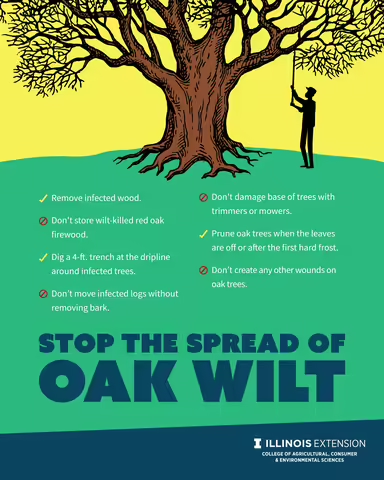SIMPSON, Ill. – Trees are an important part of the natural landscapes of Illinois. Even though Illinois is called the Prairie State, it was historically over one-third forested and still boasts nearly 5 million acres of forests. Oaks play an important role in those forests. Oaks are the most abundant group of trees in Illinois. You can find them in nearly every stand of trees across the state, from low bottomland to dry uplands. Oaks are important wildlife food, valuable timber, and make great shade trees for your yard.
"Oak wilt is a fungal disease that threatens our oaks and can be found anywhere in the state," says Chris Evans, University of Illinois Extension forestry research specialist. While all oaks can be killed by oak wilt, the red oak species are much more susceptible.
"In Illinois, we have 12 species in the red oak group, including the northern red oak, pin oak, black oak, shingle oak, and cherrybark oak," Evans says. "These trees, once infected with oak wilt, can die in as little as three to four weeks."
White oak species, such as white oak, post oak, and bur oak, will often take several years to succumb to oak wilt and can sometimes even survive an infection.
Oak wilt symptoms often start at the top of the tree and rapidly progress downward in red oaks, Evans says. Leaves turn color, starting at the tips or outer margins and, likely, prematurely fall from the tree. Trees may display dark staining in the wood of small branches or under the bark on larger stems. In white oaks, the disease may be limited to one branch and will not likely show rapid progression.
Causes of spread
"Oak wilt can move from tree to tree via root grafts, often causing large clumps of dead trees," Evans says. "This is most likely to happen in forests with a lot of red oaks clumped together."
Another major avenue of spread for oak wilt is through small sap-feeding beetles, called picnic beetles. "These beetles are attracted to the fruity odor and sap produced as the oak wilt fungal mats push apart the weakened wood and bark," Evans says. "As they feed on the sap, the beetles also pick up oak wilt spores."
Sap beetles fly to an uninfected tree and spread the disease. Wounds on oak trees will produce sap that attract these beetles. The disease expands after storm events, such as ice storms, that damage otherwise healthy trees.
Stop the spread
Three practices can limit the impact of oak wilt and slow the spread of the disease. "If you have a tree that is dying from oak wilt, remove infected wood, ideally before the next growing season, Evans says. "Do not store wilt-killed red oak firewood or move logs without the bark being removed. This wood can still produce fungal mats and spores that spread the disease."
In addition, trench around trees with oak wilt at the dripline may help prevent this type of spread through root grafts. Trenches should be around 4-feet deep near the dripline of the tree. A second line of trenches further out helps as well.
And, never prune oak trees during the growing season. "Pruning creates a wound on the tree that will leak sap and attract picnic beetles that might be carrying oak wilt spores with them," Evans says. "Only prune oak trees when the leaves are off or after the first hard frost.
Homeowners should also avoid creating any wounds on oak trees, regardless of the known presence of oak wilt, by using caution with trimmers and lawn mowers near the base of the tree.
SOURCE: Chris Evans, University of Illinois Extension. Chris Evans is a Forestry Extension and Research Specialist and currently also serves as the interim State Master Naturalist Coordinator. He is based at the Dixon Springs Agricultural Center in Southern Illinois.
